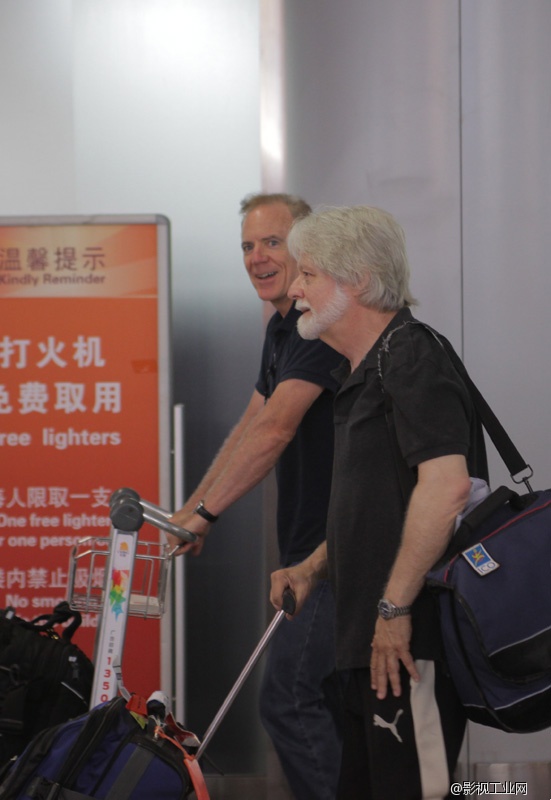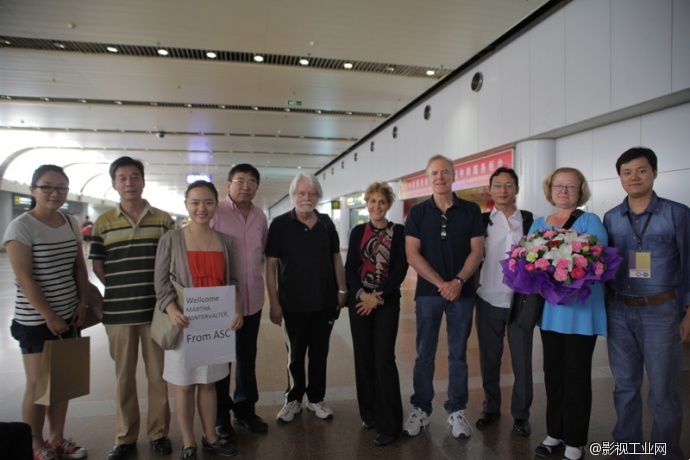美国电影摄影师协会抵达北京,并与中国影视摄影师学会首次正式见面!

接机照,随行翻译的女孩是童星张懿婧,现就读于哥伦比亚大学学习电影

左为:影视工业网副总裁杜昌博 右为:中国影视摄影师学会会长穆德远老师

美国电影摄影师协会主席 理查德·P·克鲁多与美国 电影摄影师协会技术委员会主席 柯蒂斯·克拉克

(随后大家很随意地见面握手,小编也没得到机会摆拍。)
图为中国影视摄影师协会秘书长蔡全永先生与美国电影摄影师协会主席团成员们
 左为:中国影视摄影师学会会长穆德远 右为:美国电影摄影师协会主席 理查德·P·克鲁多
左为:中国影视摄影师学会会长穆德远 右为:美国电影摄影师协会主席 理查德·P·克鲁多

影视工业网副总裁杜昌博与美国电影摄影师协会主席 理查德·P·克鲁多

随行翻译刘楠与理查德·P·克鲁先生

影视工业网副总裁杜昌博与《美国电影摄影师》杂志出版商 玛莎·温特哈尔特

大家的合影一张
最后附上:美国电影摄影师协会主席 理查德·P·克鲁多 致辞
谢谢大家。我们极其荣幸可以来到这里,我谨代表美国电影摄影师学会感谢贵方给予的这个难得机会。我敢说,学会的其他会员都对我们的中国之行眼红得不行。
自从成立以来,美国电影摄影师学会就是一个专业的团体,一个教育的团体,一个互助的团体——它是电影业中历史最悠久的组织——我们的根源可以追溯到1919年。美国电影摄影师学会还是一个名誉团体,我们只会向那些始终在电影行业占有一席之地的摄影指导们发出邀请。学会总部设在好莱坞,自1920年来,每个月都会出版《美国电影摄影师》杂志...这只是我们所有努力的一小部分。我们还出版了行业圣经——《美国电影摄影师手册》,它的最新版本最近刚刚上市。
我们的座右铭是:进步——艺术性,但除此之外,还可以加上“教育”,因为我们常会跟不少学生扯上关系。我们觉得,让他们在年轻时以正确的方式思考是最好不过的。
我现在越来越认可这个说法:我们既是艺术家,也是科学家。只是对艺术的偏重更多了那么一点点。
作为导演的右手,我们是他们最亲密的合作者,不管是在摄制过程中,还是在摄制结束时,我们在暗房监督胶片冲印,也为数字中间片或电视电影套件进行数字编码。
为什么是我,而不是演员、作家、制作设计师,甚至制片人敢这么说呢?
因为两个理由:
第一,显而易见,电影是一种视觉艺术。除了导演,摄影师是唯一一个会参与整个电影视觉计划的人。
支持这一论点的第二个事实是,我们是唯一参与把导演对故事的演绎变成现实的摄制相关人员。
不必细说,美国电影摄影师学会,以及贵组织,还有我们的姐妹组织在世界各地的成员都是技术精湛的专业人士——这就是我们成为艺术家的原因——我们在能力范围内让梦想成真。我的意思是说,如果你有个很好的创意,想把它画成一幅画,但是你又不懂画画,那么这个创意的价值何在?
当然,摄影这个专长只意味着我们具有某些技能,在工作时,我们大可完全忘记这一点。
我经常把我们的工作和爵士音乐家的相比。我们必须完全掌控自己的乐器,我们必须时刻总信心十足,在任何时候都能去实践我们选择的富有创意的方向。
此外,你可别忘了,我们的艺术和手艺是迄今为止摄制电影中会最直接接触到的。这种工作的本性总结起来很简单:如果没有光,就没有电影。
在我继续之前,有件事情必须先说清楚。从一开始,对于美国电影摄影师学会而言,胶片技术与数码技术之争就永远不是问题。如你所知,电影摄影师一直是电影工业行业进步的历史推动者。而且,我们也乐于接受那些具有价值的事物,换句话说,我们接受一切能让我们更加富有创意、更加高效率地完成工作的事物。我有一个相关的例子。但是以我的视角来看,它包含的意义还要比这一点更加丰富。
前几天晚上,我运气不错,连续看了两部电影。一部是由美国电影摄影师学会会员,约瑟夫·麦克唐纳于1946年拍摄的《死角》,另一部电影是美国电影摄影师学会会员约瑟夫·布伦于1959年拍摄的《罪魁伏法记》。两部片子都是B级片,色彩均为黑白,也都是黑色电影。它们是当时非常典型的好莱坞工作室的产物。讲述的故事都很平淡,不过技巧圆熟,令人很是享受。可是,给我留下最深刻印象的却是片子中那无法磨灭的激情。时至今日,我仍然会感觉到这种激情似乎要冲下银幕,朝我扑来!这跟他们使用什么技术来拍摄电影并无关系。这些技术在我们今天的眼光来看可谓相当粗糙。但对于麦克唐纳和布伦来说,这部片子是他们的工作,是他们的职业文化。正是如此,在片中才蕴含了他们心中追求,试图确保的“重中之重”。尽管这两部片子只能算是二线电影,但我向你保证,它们之中包含的意义,远远不止是有什么东西被“拍下来”了,或者被“发现了”。我也确信,没有人看过片子还会唉声叹气,无精打采,或者感叹这部片子还算不上“A”级制作。
我们正需要这个准则为摄影界灌输更大的活力。社会改变了,电影也改变了。但是我们工作的性质以及驱使我们工作的动机却没有改变。如果我们失败,电影之美也将永远遗失。如果你觉得有些更好的东西会来填补电影的空缺,就大错特错了。当然,激情仍然会存在。可是就算我们承认激情十分重要,激情也没有办法凭空满足需求。
情绪和机器密不可分,这个想法并非少见——自然,这个想法必会让我们审视自己所使用的技术。只有在充满创意的人手里,这些帮助我们拼凑起一部电影的工具才能获得生命。这就是许多为什么所谓的专家会把主次颠倒。他们忘记了,技术仅仅是达到目的的手段,而不是目的本身。
如果没有最初的、充满激情的冲动,把一个想法——一种感觉——转化为具体的形式,那么就算拥有世界上最好的设备,也无异于多了一堆垃圾在手。
同样,几乎每隔一段时间,业内都会烧起一股歪风,试图把复杂的问题归结为生硬的短语。比如说,在过去的十年内,大概每个人都听过这句话:我们生活在一个伟大变革的时代。嗯,难道我们不是一直生活在伟大的变革时代么?
在电影摄影师的世界里,一切都在变化,唯有“变化”一事岿然不动。如果我们没有超强的适应力,那么谁都没有办法度过这样持续不断的动乱。尽管使用相同的相机,镜头,照明设备等,但让它们的效果“个性化”——让这些器材属于我们,把器材用出自己的风格——这才是我们可以真正留下东西的方式。这也使我们在最好的情况下,能够创造出一些世人所谓的——我敢说——艺术?
无论未来如何变幻,有些事情永远都不会变。作家仍然需要幻想精彩的新故事。制片人将聚集人员,收集资源,使一切成为可能。导演仍会导演,演员仍会演出。摄影师将继续拍摄镜头,为摄制现场照明,并在后期工作中发挥作用。但是另一方面,观众却没有必要为我们的电影买单。今年夏天那些卖座电影的巨大失败就足以证明这一点了。
然而,电影摄影师还有着激情四溢的信条——我相信在场的每个人都已将这信条融入骨血——只要世上电影还存在一日,它都将继续激励和点亮我们的前路。
现在,我们比以往任何时候更加义不容辞,要恪守这一信条——不管我们未来会使用什么样的工具,我们必须要忠于这个信条,并将它滋养壮大。
英文版:
Thank you everyone. It’s a tremendous honor to be here and I want to thank you on behalf of the American Society of Cinematographers for this wonderful opportunity. I assure you that all of our members at home are envious that we got to make this trip.
For the record, the ASC is a professional, educational and fraternal group - the oldest organization in the motion picture industry — with our roots dating back to 1919. The ASC is also an honorary group, with membership by invitation only to directors of photography who have consistently distinguished themselves. We’re headquartered in Hollywood and among our many efforts, we have published American Cinematographer magazine every month since 1920...and we also publish the industry bible, the American Cinematographer Manual, the newest edition of which was just recently released.
Our motto is – Progress – Artistry, but in addition to that, you might also add Education, because we’re involved in an enormous number of student-related pursuits. We figure it’s best to get them thinking the right way while they’re young.
More than ever I think it’s proper that we think of ourselves as artist scientists, with only a slightly heavier emphasis on the artist part.
As the right hand of the director we are their closest collaborator during production and then again at the end of the process when we supervise the film’s printing at the lab and it’s digital mastering in the DI or telecine suite.
What right do I have to make that claim rather than the actors, writers, production designers, producers or so on?
Because of 2 things:
Number
1, obviously, movies are a visual art. Along with the director, the cinematographer is the only individual
privy to the entire visual plan for a film.
The second fact that backs me up is that we are the only individuals involved with a production that is charged with turning the director’s interpretation of the story into physical reality.
Suffice to say that every one of us at the ASC as well as the members of your esteemed organization and all our sister organizations around the world are consummate technicians — and this is what allows us to be artists — in whatever degree we’re capable. I mean, if you have a great idea for a painting but don’t know how to paint, what good is your idea, right?
Well,this expertise only means something in as much it frees us up to be able to throw it away when we work.
I often compare what we do in many ways to what jazz musicians do. We must have total command of our instrument, but always with the confidence to go off in any creative direction we chose at any time we chose.
Also, you can’t forget that ours is by far the most immediate of the arts and crafts that make up a film. The critical nature of what we do is summed up very simply: if there’s no light, there’s no movie.
There’s one thing I’d like to clear up before I go any further: from the very beginning - the issue of film technology versus digital technology was never an issue for us at the ASC. As you know, cinematographers have historically been the driving force behind much of the technical advancement of the movie industry and have always embraced the things worthy of being embraced, in other words those that help us do our jobs more creatively and efficiently. I have a related example though; that looks at this idea from what I think is a more sophisticated angle....
A few evenings ago I had the great good fortune to see two movies in quick succession: The Dark Corner, photographed in 1946 by Joseph MacDonald, ASC and Odds Against Tomorrow, shot in 1959 by Joseph Brun, ASC. Both were film noir, black and white B-titles, very typical of the Hollywood studio system at the time. Both were pedestrian stories at best but expertly crafted and thoroughly enjoyable. What caused them to stick with me though was the undeniable passion with which they were made. Here it is, all these years later and the feeling I describe just leaped off the screen. This had nothing to do with whatever technology they used to make those movies, which by our standards today would be quite primitive. But even if this was just another job of work for MacDonald and Brun, it was their professional culture that ensured - and enabled - the high premium.
Even though these were essentially second tier films, I assure you there was nothing merely “captured” or "found" about either of them. I’m also pretty sure no one was loafing or dragging their feet or bemoaning the fact that this wasn’t an "A" level production.
And it’s precisely this ethic that we need to bring with greater vigor to the cinematography community. Society has changed, movies have changed.
The nature of our work and the motivations we bring to it hasn’t. If we fail, the beauty of motion pictures will be lost forever. And if you think something better will evolve to fill the void, you’re wrong. Of course, passion will still exist. But essential as it is, it cannot be manufactured on demand.
The idea that emotions and machines are intertwined is not an unusual one - and this of course brings us to the technologies that we use. What’s unique is that the tools that help put a film together come to life only in creative hands. This’s where many so-called experts go wrong in their approach to the subject.
They forget that technology is only the means to an end, not the end itself.
Without an initial, passionate impulse to translate an idea — a feeling — into concrete form, even the best equipment in the world ends up nothing more than a pile of junk.
In a similar vein, every so often the industry gets caught up in a frenzy that finds it trying to reduce complex issues to a rote phrase. For example, it seems all we’ve heard for the past decade or so is that we’re living in a time of great change. Well, the truth is we have always been living in a time of great change.
Change is the single immutable fact in the cinematographer’s world. And not even a single one of us would
be able to survive such constant tumult without a superior ability to adapt. Despite using the same cameras, lenses, lighting equipment and so on, the talent for “personalizing” their effect — for making it our own, individually — is ultimately what enables us to put our own stamp on something.
Under the best of circumstances it’s also what allows us to create what some might recognize - dare I say it - as art?
Whatever the future holds, some things remain forever certain. Writers will still need to dream up wonderful new stories.
Producers will gather the people and resources that make everything possible. Directors will direct,
actors will act. Cinematographers will continue to compose their shots, light them and use their expertise on the set and in post. Audiences, on the other hand, will be under no such obligation to fill our theaters. The
spectacular failure of so many tent pole films this summer is proof enough of that.
Nonetheless, the passionate ethic of the cinematographer — something I believe every one of us in this room carries in our bones — will continue to inspire and illuminate for as long as there are motion pictures.
Now, more than ever, it’s incumbent upon us all to remain faithful to that ideal, to nurture it and see that it grows regardless of what future tools we might use.
更多此活动信息可关注:美国摄影师协会(ASC)主席团访华交流活动专题

(随后大家很随意地见面握手,小编也没得到机会摆拍。)
图为中国影视摄影师协会秘书长蔡全永先生与美国电影摄影师协会主席团成员们
 左为:中国影视摄影师学会会长穆德远 右为:美国电影摄影师协会主席 理查德·P·克鲁多
左为:中国影视摄影师学会会长穆德远 右为:美国电影摄影师协会主席 理查德·P·克鲁多
影视工业网副总裁杜昌博与美国电影摄影师协会主席 理查德·P·克鲁多

随行翻译刘楠与理查德·P·克鲁先生

影视工业网副总裁杜昌博与《美国电影摄影师》杂志出版商 玛莎·温特哈尔特

大家的合影一张
最后附上:美国电影摄影师协会主席 理查德·P·克鲁多 致辞
谢谢大家。我们极其荣幸可以来到这里,我谨代表美国电影摄影师学会感谢贵方给予的这个难得机会。我敢说,学会的其他会员都对我们的中国之行眼红得不行。
自从成立以来,美国电影摄影师学会就是一个专业的团体,一个教育的团体,一个互助的团体——它是电影业中历史最悠久的组织——我们的根源可以追溯到1919年。美国电影摄影师学会还是一个名誉团体,我们只会向那些始终在电影行业占有一席之地的摄影指导们发出邀请。学会总部设在好莱坞,自1920年来,每个月都会出版《美国电影摄影师》杂志...这只是我们所有努力的一小部分。我们还出版了行业圣经——《美国电影摄影师手册》,它的最新版本最近刚刚上市。
我们的座右铭是:进步——艺术性,但除此之外,还可以加上“教育”,因为我们常会跟不少学生扯上关系。我们觉得,让他们在年轻时以正确的方式思考是最好不过的。
我现在越来越认可这个说法:我们既是艺术家,也是科学家。只是对艺术的偏重更多了那么一点点。
作为导演的右手,我们是他们最亲密的合作者,不管是在摄制过程中,还是在摄制结束时,我们在暗房监督胶片冲印,也为数字中间片或电视电影套件进行数字编码。
为什么是我,而不是演员、作家、制作设计师,甚至制片人敢这么说呢?
因为两个理由:
第一,显而易见,电影是一种视觉艺术。除了导演,摄影师是唯一一个会参与整个电影视觉计划的人。
支持这一论点的第二个事实是,我们是唯一参与把导演对故事的演绎变成现实的摄制相关人员。
不必细说,美国电影摄影师学会,以及贵组织,还有我们的姐妹组织在世界各地的成员都是技术精湛的专业人士——这就是我们成为艺术家的原因——我们在能力范围内让梦想成真。我的意思是说,如果你有个很好的创意,想把它画成一幅画,但是你又不懂画画,那么这个创意的价值何在?
当然,摄影这个专长只意味着我们具有某些技能,在工作时,我们大可完全忘记这一点。
我经常把我们的工作和爵士音乐家的相比。我们必须完全掌控自己的乐器,我们必须时刻总信心十足,在任何时候都能去实践我们选择的富有创意的方向。
此外,你可别忘了,我们的艺术和手艺是迄今为止摄制电影中会最直接接触到的。这种工作的本性总结起来很简单:如果没有光,就没有电影。
在我继续之前,有件事情必须先说清楚。从一开始,对于美国电影摄影师学会而言,胶片技术与数码技术之争就永远不是问题。如你所知,电影摄影师一直是电影工业行业进步的历史推动者。而且,我们也乐于接受那些具有价值的事物,换句话说,我们接受一切能让我们更加富有创意、更加高效率地完成工作的事物。我有一个相关的例子。但是以我的视角来看,它包含的意义还要比这一点更加丰富。
前几天晚上,我运气不错,连续看了两部电影。一部是由美国电影摄影师学会会员,约瑟夫·麦克唐纳于1946年拍摄的《死角》,另一部电影是美国电影摄影师学会会员约瑟夫·布伦于1959年拍摄的《罪魁伏法记》。两部片子都是B级片,色彩均为黑白,也都是黑色电影。它们是当时非常典型的好莱坞工作室的产物。讲述的故事都很平淡,不过技巧圆熟,令人很是享受。可是,给我留下最深刻印象的却是片子中那无法磨灭的激情。时至今日,我仍然会感觉到这种激情似乎要冲下银幕,朝我扑来!这跟他们使用什么技术来拍摄电影并无关系。这些技术在我们今天的眼光来看可谓相当粗糙。但对于麦克唐纳和布伦来说,这部片子是他们的工作,是他们的职业文化。正是如此,在片中才蕴含了他们心中追求,试图确保的“重中之重”。尽管这两部片子只能算是二线电影,但我向你保证,它们之中包含的意义,远远不止是有什么东西被“拍下来”了,或者被“发现了”。我也确信,没有人看过片子还会唉声叹气,无精打采,或者感叹这部片子还算不上“A”级制作。
我们正需要这个准则为摄影界灌输更大的活力。社会改变了,电影也改变了。但是我们工作的性质以及驱使我们工作的动机却没有改变。如果我们失败,电影之美也将永远遗失。如果你觉得有些更好的东西会来填补电影的空缺,就大错特错了。当然,激情仍然会存在。可是就算我们承认激情十分重要,激情也没有办法凭空满足需求。
情绪和机器密不可分,这个想法并非少见——自然,这个想法必会让我们审视自己所使用的技术。只有在充满创意的人手里,这些帮助我们拼凑起一部电影的工具才能获得生命。这就是许多为什么所谓的专家会把主次颠倒。他们忘记了,技术仅仅是达到目的的手段,而不是目的本身。
如果没有最初的、充满激情的冲动,把一个想法——一种感觉——转化为具体的形式,那么就算拥有世界上最好的设备,也无异于多了一堆垃圾在手。
同样,几乎每隔一段时间,业内都会烧起一股歪风,试图把复杂的问题归结为生硬的短语。比如说,在过去的十年内,大概每个人都听过这句话:我们生活在一个伟大变革的时代。嗯,难道我们不是一直生活在伟大的变革时代么?
在电影摄影师的世界里,一切都在变化,唯有“变化”一事岿然不动。如果我们没有超强的适应力,那么谁都没有办法度过这样持续不断的动乱。尽管使用相同的相机,镜头,照明设备等,但让它们的效果“个性化”——让这些器材属于我们,把器材用出自己的风格——这才是我们可以真正留下东西的方式。这也使我们在最好的情况下,能够创造出一些世人所谓的——我敢说——艺术?
无论未来如何变幻,有些事情永远都不会变。作家仍然需要幻想精彩的新故事。制片人将聚集人员,收集资源,使一切成为可能。导演仍会导演,演员仍会演出。摄影师将继续拍摄镜头,为摄制现场照明,并在后期工作中发挥作用。但是另一方面,观众却没有必要为我们的电影买单。今年夏天那些卖座电影的巨大失败就足以证明这一点了。
然而,电影摄影师还有着激情四溢的信条——我相信在场的每个人都已将这信条融入骨血——只要世上电影还存在一日,它都将继续激励和点亮我们的前路。
现在,我们比以往任何时候更加义不容辞,要恪守这一信条——不管我们未来会使用什么样的工具,我们必须要忠于这个信条,并将它滋养壮大。
英文版:
Thank you everyone. It’s a tremendous honor to be here and I want to thank you on behalf of the American Society of Cinematographers for this wonderful opportunity. I assure you that all of our members at home are envious that we got to make this trip.
For the record, the ASC is a professional, educational and fraternal group - the oldest organization in the motion picture industry — with our roots dating back to 1919. The ASC is also an honorary group, with membership by invitation only to directors of photography who have consistently distinguished themselves. We’re headquartered in Hollywood and among our many efforts, we have published American Cinematographer magazine every month since 1920...and we also publish the industry bible, the American Cinematographer Manual, the newest edition of which was just recently released.
Our motto is – Progress – Artistry, but in addition to that, you might also add Education, because we’re involved in an enormous number of student-related pursuits. We figure it’s best to get them thinking the right way while they’re young.
More than ever I think it’s proper that we think of ourselves as artist scientists, with only a slightly heavier emphasis on the artist part.
As the right hand of the director we are their closest collaborator during production and then again at the end of the process when we supervise the film’s printing at the lab and it’s digital mastering in the DI or telecine suite.
What right do I have to make that claim rather than the actors, writers, production designers, producers or so on?
Because of 2 things:
Number
1, obviously, movies are a visual art. Along with the director, the cinematographer is the only individual
privy to the entire visual plan for a film.
The second fact that backs me up is that we are the only individuals involved with a production that is charged with turning the director’s interpretation of the story into physical reality.
Suffice to say that every one of us at the ASC as well as the members of your esteemed organization and all our sister organizations around the world are consummate technicians — and this is what allows us to be artists — in whatever degree we’re capable. I mean, if you have a great idea for a painting but don’t know how to paint, what good is your idea, right?
Well,this expertise only means something in as much it frees us up to be able to throw it away when we work.
I often compare what we do in many ways to what jazz musicians do. We must have total command of our instrument, but always with the confidence to go off in any creative direction we chose at any time we chose.
Also, you can’t forget that ours is by far the most immediate of the arts and crafts that make up a film. The critical nature of what we do is summed up very simply: if there’s no light, there’s no movie.
There’s one thing I’d like to clear up before I go any further: from the very beginning - the issue of film technology versus digital technology was never an issue for us at the ASC. As you know, cinematographers have historically been the driving force behind much of the technical advancement of the movie industry and have always embraced the things worthy of being embraced, in other words those that help us do our jobs more creatively and efficiently. I have a related example though; that looks at this idea from what I think is a more sophisticated angle....
A few evenings ago I had the great good fortune to see two movies in quick succession: The Dark Corner, photographed in 1946 by Joseph MacDonald, ASC and Odds Against Tomorrow, shot in 1959 by Joseph Brun, ASC. Both were film noir, black and white B-titles, very typical of the Hollywood studio system at the time. Both were pedestrian stories at best but expertly crafted and thoroughly enjoyable. What caused them to stick with me though was the undeniable passion with which they were made. Here it is, all these years later and the feeling I describe just leaped off the screen. This had nothing to do with whatever technology they used to make those movies, which by our standards today would be quite primitive. But even if this was just another job of work for MacDonald and Brun, it was their professional culture that ensured - and enabled - the high premium.
Even though these were essentially second tier films, I assure you there was nothing merely “captured” or "found" about either of them. I’m also pretty sure no one was loafing or dragging their feet or bemoaning the fact that this wasn’t an "A" level production.
And it’s precisely this ethic that we need to bring with greater vigor to the cinematography community. Society has changed, movies have changed.
The nature of our work and the motivations we bring to it hasn’t. If we fail, the beauty of motion pictures will be lost forever. And if you think something better will evolve to fill the void, you’re wrong. Of course, passion will still exist. But essential as it is, it cannot be manufactured on demand.
The idea that emotions and machines are intertwined is not an unusual one - and this of course brings us to the technologies that we use. What’s unique is that the tools that help put a film together come to life only in creative hands. This’s where many so-called experts go wrong in their approach to the subject.
They forget that technology is only the means to an end, not the end itself.
Without an initial, passionate impulse to translate an idea — a feeling — into concrete form, even the best equipment in the world ends up nothing more than a pile of junk.
In a similar vein, every so often the industry gets caught up in a frenzy that finds it trying to reduce complex issues to a rote phrase. For example, it seems all we’ve heard for the past decade or so is that we’re living in a time of great change. Well, the truth is we have always been living in a time of great change.
Change is the single immutable fact in the cinematographer’s world. And not even a single one of us would
be able to survive such constant tumult without a superior ability to adapt. Despite using the same cameras, lenses, lighting equipment and so on, the talent for “personalizing” their effect — for making it our own, individually — is ultimately what enables us to put our own stamp on something.
Under the best of circumstances it’s also what allows us to create what some might recognize - dare I say it - as art?
Whatever the future holds, some things remain forever certain. Writers will still need to dream up wonderful new stories.
Producers will gather the people and resources that make everything possible. Directors will direct,
actors will act. Cinematographers will continue to compose their shots, light them and use their expertise on the set and in post. Audiences, on the other hand, will be under no such obligation to fill our theaters. The
spectacular failure of so many tent pole films this summer is proof enough of that.
Nonetheless, the passionate ethic of the cinematographer — something I believe every one of us in this room carries in our bones — will continue to inspire and illuminate for as long as there are motion pictures.
Now, more than ever, it’s incumbent upon us all to remain faithful to that ideal, to nurture it and see that it grows regardless of what future tools we might use.
更多此活动信息可关注:美国摄影师协会(ASC)主席团访华交流活动专题
本文为作者 107活动 分享,影视工业网鼓励从业者分享原创内容,影视工业网不会对原创文章作任何编辑!如作者有特别标注,请按作者说明转载,如无说明,则转载此文章须经得作者同意,并请附上出处(影视工业网)及本页链接。原文链接 https://cinehello.com/stream/17909
